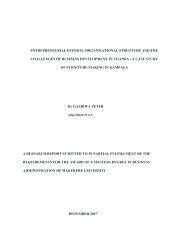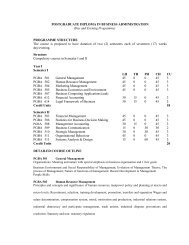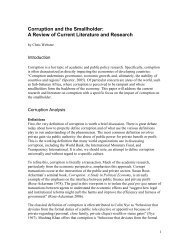13th Annual International Management Conference Proceeding
13th Annual International Management Conference Proceeding
13th Annual International Management Conference Proceeding
You also want an ePaper? Increase the reach of your titles
YUMPU automatically turns print PDFs into web optimized ePapers that Google loves.
economy activities that include one or more persons or enterprises in the formal economy employing up to 50 persons<br />
(Stevenson and St-Onge, 2005). The Ministry of Labour and Human Resource Development (MLHRD, 2004),<br />
which is the lead agency for the SME sector, makes provision for both formal and informal enterprises, classified into<br />
farm and non-farm categories, employing 1 – 50 employees (MLHRD, 2004).<br />
Considering the fact that Kenya has unemployment rate of 50%, and a labour force of 9.2 million (1998 est.) of<br />
which agriculture takes 75%-80%, the importance of SMEs in economic development especially the aspects of job<br />
and wealth creation in Kenya cannot be more emphasized (1Up Travel (n.d)). Njeru (2006) has underscored this<br />
point by arguing that “Small Medium Enterprises (SMEs) play a major a role economic development as they generate<br />
jobs hence eliminating poverty that afflicts people; however, they are faced with challenges such as small local markets,<br />
inadequate region integration, poor infrastructure, failure to access credit and adopt information and communication<br />
technologies (ICT) among others.” They employ more than half of the workforce (Mahinda, 2004). It is hence<br />
imperative that the capabilities of the SMEs be increased for the future of Kenya’s economic deveopment. Research has<br />
shown that with the increase in access and affordability of Information Technology and Communications (ICTS),<br />
companies have adopted technologies to make their management more effective. However, this is not the case with<br />
most SMEs in Kenya (Njeru, 2006) .<br />
According to the (CBS, 1999), there were approximately 1.3 million SMEs, creating employment for 2.3 million<br />
people. An estimated 26 percent of households were involved in some kind of non-primary business activity.<br />
Approximately two-thirds of Kenyan SMEs are located in the rural areas which provides home to over 80 percent of<br />
the population (CBS, 1999). The survey indicated that only 11.7 per cent of SMEs indicated they were registered and<br />
39.4 per cent operated with licenses. About two-thirds of all enterprises were in the trade of buying and selling<br />
commodities while 13 and 15 per cent were in manufacturing and services respectively.<br />
According to the Department of SME development, the SME sector experienced growth from 2000 – 2002,<br />
increasing to 2.8 million enterprises with employment of 5.1 million persons, accounting for 74.2 per cent of total<br />
employment in 2002 (MPND, 2003; ERS, 2003). This dramatic increase was largely due to retrenchment in both the<br />
public and private sectors. In 1999, the average size of an SME was 1.8 persons. The owners themselves accounted for<br />
almost 75 per cent of total SME employment. In fact, 80 per cent of total SME employment involved only the owners<br />
and their family members (CBS, 1999). Only 11.6 per cent accounted for regular hired employees in SME<br />
employment. Ninety six point seven percent of SMEs employ less than five employees, 2.6 per cent employ 6 – 10<br />
persons. There were no employees in the rural towns and areas with more than 15 employees and none in the major<br />
towns with more than 25 employees (Stevenson and St-Onge, 2005). The SME sector in Kenya is mainly<br />
concentrated in the micro enterprise segment. Only 9041 SMEs fell into the category of small. These small firms<br />
accounted for an estimated 154,267 workers or a paltry 5 per cent of total SME employment. This lack of enterprises<br />
in the 11- 50 employee range comprises a missing middle both in terms of numbers of enterprises and their<br />
contribution to employment (Stevenson and St-Onge, 2005)<br />
United States Agency for <strong>International</strong> Development (USAID) support to the (MSME) sector has had major impacts<br />
on its development which is important to the overall welfare of the population in Kenya. To illustrate this<br />
importance, a 1999 survey estimated that there are 1.3 million micro-enterprises employing 2.4 million people, two<br />
thirds of whom are in rural areas. This figures increases to 5 million people, an equivalent of 30% of Kenya's labour<br />
force, when informal businesses are included. They contribute 18% of the country's Gross Domestic Product.<br />
According to figures released by IFC (2006) Statistics, the total number of SMEs in Kenya in 2004 was about<br />
22,104 giving a figure of 0.7 SMEs per 1000 people (IFC, 2006). A Comparison of 11 African countries shown in<br />
Figure 1 reveals that the 0.7 SMEs per 1000 people index for Kenya is the lowest in the group, yet SMEs contribute<br />
74.2% of total employment (IFC, 2005). The Kenyan Government realizes this and aims to groom SMEs into<br />
globally competitive business entities. To foster growth of a strong SME sector, the government has embarked on a<br />
number of SMEs sector reforms.<br />
32
















